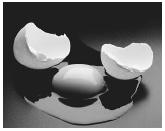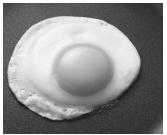Denaturation

Protein molecules carry out many important tasks in living systems. Most important, the majority of proteins are quite specific about which task they perform. Protein structure is what dictates this specificity, and the three-dimensional (tertiary) structure is particularly important. When this specific three-dimensional structure is disrupted, the protein loses its functionality and is said to have undergone denaturation.
The interactions, such as hydrogen bonding , that dictate the tertiary structure of proteins are not as strong as covalent chemical bonds. Because these interactions are rather weak, they can be disrupted with relatively modest stresses.
If a solution containing a protein is heated, it will reach a temperature at which properties such as viscosity or the absorption of ultraviolet (UV) light will change abruptly. This temperature is called the melting temperature of the protein (because the measurement is analogous to that made for the melting of a solid). The melting temperature varies for different proteins, but temperatures above 41°C (105.8°F) will break the interactions in many proteins and denature them. This temperature is not that much higher than normal body temperature (37°C or 98.6°F), so this fact demonstrates how dangerous a high fever can be.
A familiar example of heat-caused denaturation are the changes observed in the albumin protein of egg whites when they are cooked. When an egg is first cracked open, the "whites" are translucent and runny (they flow like a liquid), but upon heating they harden and turn white. The change in viscosity and color is an indication that the proteins have been denatured.
Factors other than heat can also denature proteins. Changes in pH affect the chemistry of amino acid residues and can lead to denaturation. Hydrogen bonding often involves these side changes. Protonation of the amino acid residues (when an acidic proton H + attaches to a lone pair of electrons on a nitrogen) changes whether or not they participate in hydrogen bonding, so a change in the pH can denature a protein.


Changes in salt concentration may also denature proteins, but these effects depend on several factors including the identity of the salt. Some salts, such as ammonium sulfate, tend to stabilize protein structures and increase the melting temperature. Others, such as calcium chloride, destabilize proteins and lower the melting temperature and are called chaotropic. Salts in this category can also be used in the laboratory to help purify proteins that are being studied, by lowering their solubility and causing them to "salt out."
SEE ALSO Heavy Metal Toxins ; Proteins .
Thomas A. Holme
Bibliography
Branden, C., and Tooze, J. (1998). Introduction to Protein Structures, 2nd edition. London: Taylor and Francis.
Creighton, T. E. (1993). Proteins, 2nd edition. New York: Freeman.
Fagain, C. O. (1997). Protein Stability and Stabilization of Protein Function. Georgetown, TX: Landes Bioscience.